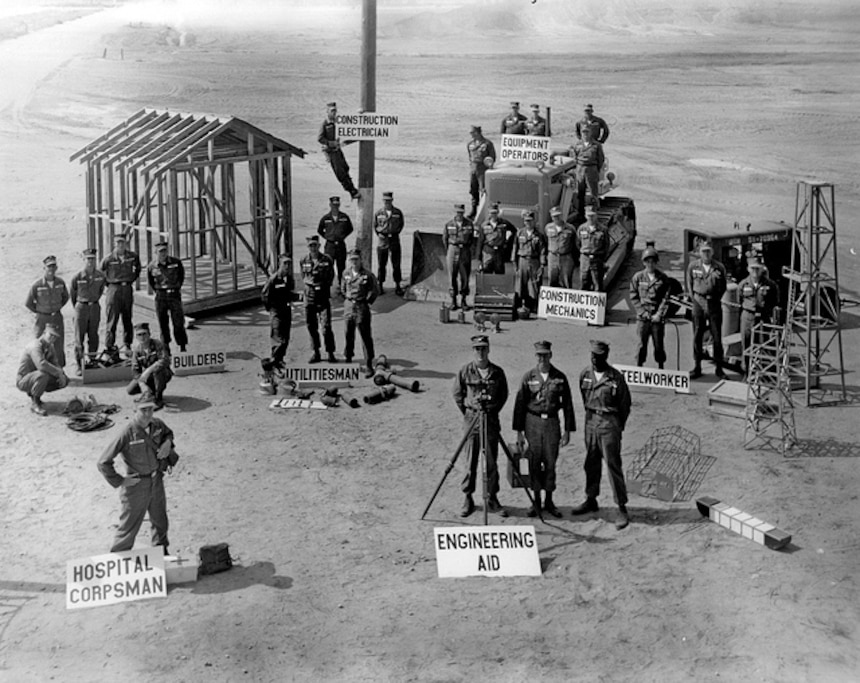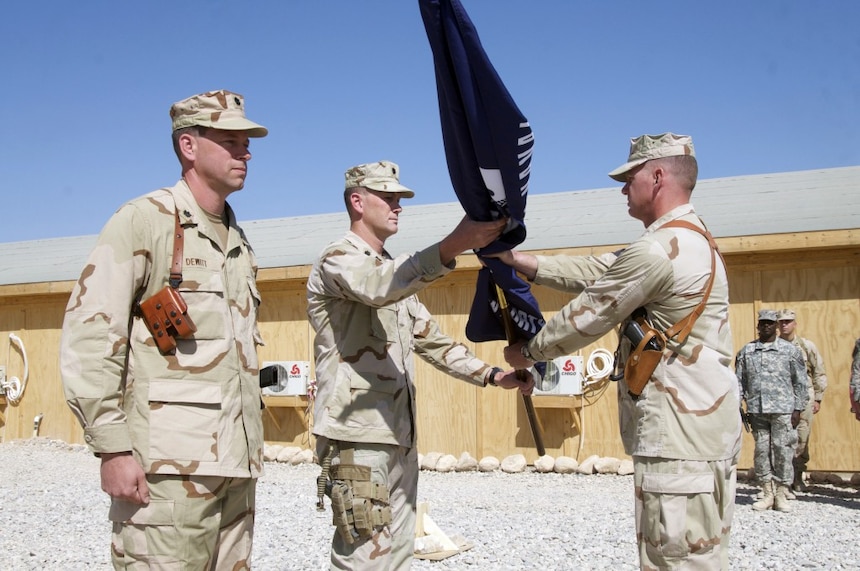Consolidated by U.S. Navy Seabee Museum, Naval History and Heritage Command
September 18
1942: Authority for the organization of a number of special-duty battalions was granted. This was the first departure from the standard battalion, and the new units were known as Special Naval Construction Battalions (NCB). These special battalions were composed of Seabee stevedores and longshoremen who were badly needed to break a bottleneck in the unloading of ships in the combat zones. Their officers, drawn largely from experienced personnel from the steamship and stevedoring companies, were commissioned in the Civil Engineer Corps (CEC). The Seabees were trained practically from scratch, and the efficiency of their training was demonstrated by the fact that cargo handling in the combat zones compared favorably with that done in the most efficient ports in the United States.
1942: The 26th NCB was commissioned at Camp Allen, Norfolk, Virginia.
1968: Builder 2nd ClassGary Murphy of New Albany, Indiana was traveling as part of a 30-truck unit of Naval Mobile Construction Battalion (NMCB) 121Seabees in a U.S. Marine Corps convoy on National Highway One, south of Phu Loc, Republic of Vietnam (RVN), when the unit came under sudden and heavy enemy fire. Heavy mortar and automatic weapons fire were directed against the Seabee vehicles from concealed enemy positions. The truck upon which Murphy was riding was disabled in the initial onslaught. From an exposed position on the rear of the truck, he laid down a heavy covering fire allowing other Seabees to reach the safety of the ditch. After they had reached cover, he withdrew to a more secure position. From there he killed two enemy soldiers who were moving toward the disabled truck. As smoke from another burning vehicle partially obscured the enemy, Murphy, without regard for his personal safety, returned to the damaged truck, climbed onto an exposed position on top of it, and retrieved a machine gun and ammunition that had been jammed in place during the initial attack. Murphy passed the gun and ammunition down to other Seabees and returned to the ditch to man the gun. An enemy sapper exposed himself and threw a satchel charge but was promptly shot down by Murphy. He then continued to direct heavy fire against the enemy positions, holding them in place until armed helicopter gunships and a Marine Corps relief force arrived. For his actions during the attack, Petty Officer Murphy was awarded the Silver Star Medal on January 23, 1969 during a ceremony at Camp Wilkinson, Gia Le, RVN.
1968: The new Seabee camp built by NMCB 11 at Quang Tri, RVNwas dedicated as Camp Rhodes, in honor of Lt. Joseph Rhodes, a CEC officer killed in action.
1970: NMCB 1 main body, with Cmdr. C.W. Popowich, CEC, commanding, deployed to Camp Moscrip, U.S. Naval Station, Roosevelt Roads, Puerto Rico.
September 19
1943: The 114th NCB commissioned at Naval Construction Training Center (NCTC) Camp Endicott, Davisville, Rhode Island.
1944: The Army Distinguished Unit Citation was presented to the 40th NCB at Camp Parks, Shoemaker, California.
1967: A silver spike ceremony was held at the Liberty Bridge over Thu Bon River south of Da Nang, RVN. Lt. Gen. Hohang Xuam Lam, Army of the Republic of Vietnam (ARVN), drove in the ceremonial spike. The 2,040-foot long bridge was built by NMCB 4.
1970: NMCB 1 departed Davisville, Rhode Island and assumed command of Camp Moscrip, Roosevelt Roads, Puerto Ricofrom NMCB 40.

The Foundation of Diego Garcia
By 1983 the only Seabee unit remaining on Diego Garcia was a detachment of NMCB 62. The departure of this detachment in September 1983 ended twelve years of priority effort on the island that included some 220 projects for the Navy and Air Force, valued in excess of $200 million. The work the Seabees completed on Diego Garcia since 1971 represented the largest peacetime construction effort in their history. Diego Garcia was the major Seabee construction effort of the 1970s and they acquitted themselves well under the difficult and isolated conditions that exist there. When the Seabees arrived they lived in tent camps, when they departed they left a fully-developed, modern military facility, capable of supporting thousands of U.S. personnel.
September 20
1942: The earliest Seabee regiment, Construction Regiment, Western Alaska, was established for construction work at Dutch Harbor, Alaska. It was later renamed the First Naval Construction Regiment (NCR) on Dec. 19, 1942.
1943: The 17th Special NCB formed at NCTC Camp Peary, Magruder, Virginia.
1945: The 95th NCB was inactivated on Iwo Jima; the 26th NCR inactivated.
1965: Construction of the Camp Hansen U.S. Marine Facility, Okinawa was finished after 29 months by NMCBs 3, 9, and 11; also, NMCB 5's main body departed Port Hueneme, California for Camp Hoover, Da Nang, RVN.
1968: The main body of NMCB 53 arrived at Davisville, Rhode Island from Da Nang, RVN.
1970: The main body of NMCB 40 arrived at Davisville, Rhode Island from Camp Moscrip, Roosevelt Roads, Puerto Rico.
September 21
1943: The 123rd NCB was commissioned at NCTC Camp Endicott, Davisville, Rhode Island.
1950: During the Inchon offensive in Korea, a detachment of Seabee volunteers from Amphibious Construction Battalion (ACB) 1 carried off an exploit typical of the many legends that have sprung up about the Seabees. Air observation reported eight locomotives trapped by broken rail lines in a switch yard at Yong Dong Po, eight miles above Inchon, Korea. A group of Seabees under a chief petty officer volunteered to go behind enemy lines and attempt to capture the engines. The Seabees sneaked down the line past enemy troops and seized the locomotives. However, when they reached the switch yard, they found a Kirin Brewery alongside the track. After thoughtful consideration, the Seabees decided to liberate not only the locomotives, but some of the beer stacked in the brewery. In quick time, the men had 15 cases of beer loaded aboard the locomotives. They then fired up the engine boilers and began the dangerous trek back to their lines. Along the way they had to repair broken track while under enemy fire. Even the United States Marines began shooting at the trains until they realized they were manned by Seabees. However, in true Seabee fashion, the men of ACB 1 brought back the liberated locomotives intact, as well as the liberated beer, no so intact.
1969: NMCB 3's main body deployed to Camp Kinser, Okinawa, via government aircraft.
September 22
1965: NMCB 3 was relieved by NMCB 5 in RVN.
1989: Hurricane "Hugo" struck the Charleston, South Carolina, area, killing 26 people and causing $5.9 billion of damage. Seabees from Naval Mobile Construction Battalion 5 and 133, home-ported at the Naval Construction Battalion Center, Gulfport, Mississippi; and Construction Battalion Unit 412 at Charleston immediately moved to provide disaster relief to both the military and civilian communities.

A home is heavily damaged near the coast of South Carolina following Hurricane Hugo coming ashore near Charleston, South Carolina, September 22, 1989. Hurricane Hugo resulted in the deaths of 27 South Carolinians and is considered one of the costliest weather events to impact the state. Hurricane season runs from June 1 to Nov. 30.
2007: Cmdr. Frederick Mucke, CEC, was relieved by Cmdr. Ronald Gruzesky, CEC, as commander, NMCB 24, at the Readiness Support Site Drill Center, Huntsville, Alabama.
September 23
1943: 116th NCB commissioned at NCTC Camp Endicott, Davisville, RI.
1965: The main body of NMCB 3, after being relieved by NMCB 5, returned to homeport via six Military Air Transport Service (MATS) aircraft.
1967: The main body of NMCB 133 departed RVN and returned to the Construction Battalion center (CBC), Gulfport, Mississippi.
2011: Adm. Michael Mullen presented Brooke Toner, widow of Lt. j.g. Francis Toner IV, CEC, with her late husband s Silver Star, awarded for action against the enemy as Garrison Engineer, Camp Mike Spann Embedded Training Team, Afghanistan. Toner was also posthumously awarded the Purple Heart and Bronze Star with Valor.
September 24
1943: ACORN 13 arrived at Espiritu Santo. (Used during World War II, an ACORN was a tailored unit designed to carry out the rapid construction and subsequent operation of a landplane and seaplane advance base. Each ACORN had a construction battalion attached to it, as well as trained personnel to operate the control tower, field lighting, aerological unit, transportation, medical, berthing, and messing facilities. A Construction Battalion Maintenance Unit (CBMU) also accompanied each ACORN to maintain the base after the initial construction was completed and the construction battalion had been withdrawn. During the war, ACORNs were sent to such places at Guadalcanal, Espiritu Santo, Green Island, Rendova, Treasury Island, and Majuro.)
1945: The 69th NCB was inactivated at Davisville, Rhode Island; the 14th Special NCB was inactivated at Pearl Harbor, Hawaii.
1967: The first flight of NMCB 128 s advance party arrived in Da Nang, RVN.
2010: Cmdr. Tim DeWitt, CEC, relieved Cmdr. Glenn Hubbard, CEC, as commanding officer, NMCB 40 at Forward Operating Base Deh Dadi II, Afghanistan.
